Draft:League of Prizren Secessionist War
 | Review waiting, please be patient.
This may take 2 months or more, since drafts are reviewed in no specific order. There are 2,102 pending submissions waiting for review.
Where to get help
How to improve a draft
You can also browse Wikipedia:Featured articles and Wikipedia:Good articles to find examples of Wikipedia's best writing on topics similar to your proposed article. Improving your odds of a speedy review To improve your odds of a faster review, tag your draft with relevant WikiProject tags using the button below. This will let reviewers know a new draft has been submitted in their area of interest. For instance, if you wrote about a female astronomer, you would want to add the Biography, Astronomy, and Women scientists tags. Editor resources
Reviewer tools
|
| League of Prizren Secessionist War | |||||||
|---|---|---|---|---|---|---|---|
| Part of the League of Prizren and the Albanian National Movement | |||||||
 Ali Pasha of Gusinje (seated, left) with Haxhi Zeka (seated, middle) and other members of the Prizren League | |||||||
| |||||||
| Belligerents | |||||||
|
|
Supported by: | ||||||
| Commanders and leaders | |||||||
|
|
| ||||||
| Strength | |||||||
| 30,000 fighters[2] | Large Ottoman Army | ||||||
| Casualties and losses | |||||||
| Unknown | Unknown | ||||||
Prelude
[edit]The Congress of Berlin (1878) reduced the Ottoman Empire’s Balkan territories, ceding Albanian-populated lands to Montenegro, Serbia, and Greece.[3] In response, the League of Prizren was established by Albanian leaders to oppose these territorial losses and push for autonomy. Initially, the League sought to resolve the issue diplomatically, but after failing to gain recognition from the Ottoman government, it turned to armed resistance.[4]
The League first fought against Montenegro, successfully repelling their advance in the Battle of Novšiće (1879).[5] However, by 1880, the League's objectives expanded to demand full autonomy within the Ottoman Empire, leading to direct confrontation with Ottoman forces.[6]
Military Resistance Against the Ottoman Empire
[edit]Seizure of Ottoman-Controlled Towns (1880–1881)
[edit]By 1880, the League had taken control of several key towns in Kosovo and northern Albania:
- Vushtrri, Peja, Mitrovica, Prizren, and Gjakova fell under League control.[6]
- In January 1881, League forces under Sulejman Vokshi captured Skopje and Prishtina.[7]
- In February 1881, the League seized Dibra, forcing the Ottoman administration to retreat.[7]
- Idriz Seferi with his men liberated Kumanovo on January 19, 1881, and Preševo on January 21, 1881.[8]
Ottoman Military Response (Spring 1881)
[edit]The rapid expansion of the League’s control and the Great Powers request "to pacify" the League alarmed the Ottoman government, leading to a major military response:
- The Ottomans dispatched a large army under Dervish Pasha to crush the rebellion.[9]
- In April 1881, Ottoman forces launched a full-scale military campaign, retaking Prizren after heavy fighting.[10]
- The final battle took place at Battle of Ulqin, where Ottoman troops decisively defeated the remaining League forces with Support of the Great Powers through a Naval Blockade.[11][12][13]
Naval Blockade of Ulqin
[edit]As the Ottoman Empire delayed the transfer of Ulqin to Montenegro by using the League, the Great Powers—the United Kingdom, France, Germany, Italy, Austria-Hungary, and Russia—intervened by organizing a large-scale naval blockade in late 1880.[14] The blockade aimed to enforce the territorial agreement stipulated in the Treaty of Berlin (1878), pressuring the Ottoman authorities to pacify the League.
The fleet, commanded by Frederick Beauchamp Seymour, 1st Baron Alcester, patrolled the Adriatic coast near Ulqin and Montenegro. Warships from all six Great Powers participated in the blockade, creating a formidable presence to deter further Albanian resistance.[15] Despite this show of force, Albanian irregulars, led by Isuf Sokoli, refused to surrender the city
Aftermath
[edit]Following the Ottoman victory, severe measures were taken against the League and its supporters:
- Many League leaders, including Sulejman Vokshi, were executed, imprisoned, or exiled.[16]
- The Ottoman government reasserted control over Kosovo and northern Albania, suppressing further resistance.[17]
- The failure of the League marked the end of Albania’s first major armed struggle for autonomy but laid the groundwork for the Albanian National Awakening and the eventual Albanian Declaration of Independence (1912).[18]
Although the League of Prizren was ultimately defeated, its military resistance played a crucial role in the development of Albanian national consciousness and future independence efforts.
See also
[edit]- League of Peja
- Albanian Revolt of 1912
- Battles for Plav and Gusnje
- Second League of Prizren
- Third League of Prizren
References
[edit]- ^ Jelavich, Barbara (1983). History of the Balkans. Cambridge University Press. p. 365. ISBN 9780521274586.
- ^ Skendi 1967, pp. 37, 96–97, 101–107.
- ^ Gawrych 2006, pp. 48–50.
- ^ Skendi 1967, pp. 43–44.
- ^ Skendi 1967, pp. 60–61.
- ^ a b Gawrych 2006, pp. 66–67.
- ^ a b Ippen, Theodor (1916). "Nineteenth-Century Albanian History". Texts and Documents of Albanian History.
- ^ "Idriz Seferi në Lëvizjet Kombëtare Shqiptare | WorldCat.org". search.worldcat.org. Retrieved 2025-01-31.
- ^ Gawrych 2006, pp. 62, 66, 68.
- ^ Gawrych 2006, pp. 62–63.
- ^ Jelavich, Barbara (1983). History of the Balkans. Cambridge University Press. p. 365. ISBN 9780521274586.
- ^ Skendi 1967, pp. 67–68, 99, 103–107.
- ^ Vickers, Miranda (28 January 2011). The Albanians: A Modern History. I.B.Tauris. ISBN 9780857710253.
- ^ Vickers, Miranda (28 January 2011). The Albanians: A Modern History. I.B. Tauris. ISBN 9780857710253.
- ^ Longley, Darren (Norm) (April 2009). The Rough Guide to Montenegro. Rough Guides Limited. ISBN 9781848362048.
- ^ Gawrych 2006, pp. 80–81.
- ^ Skendi 1967, p. 82.
- ^ Gawrych 2006, pp. 63, 68.
